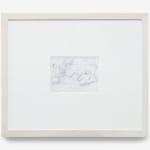-
Artworks
Tom Wesselmann
Drawing for Sunset Nude (Big Scene), 2002Graphite on transparent paper3 1/8 x 4 1/4 in (7.9 x 10.8 cm)© 2025 Tom Wesselmann. Courtesy of Zeit Contemporary Art, New YorkTom Wesselmann's 'Drawing for Sunset Nude (Big Scene)' from 2002 is a delicate graphite sketch on transparent paper, capturing the essence of the female form with a simplicity that belies...Tom Wesselmann's "Drawing for Sunset Nude (Big Scene)" from 2002 is a delicate graphite sketch on transparent paper, capturing the essence of the female form with a simplicity that belies its complexity. In this work, Wesselmann uses the pencil with a masterful restraint, allowing the soft, flowing lines to evoke the curves of the body in an almost ethereal manner. The transparency of the paper enhances the sense of lightness and fluidity, as if the figure is gently emerging from or dissolving into the surrounding space. This drawing, though intimate in scale, reveals Wesselmann’s deep commitment to the exploration of form, space, and the interplay of figure and environment.
The "Sunset Nude" series, to which this drawing belongs, represents a mature phase in Wesselmann’s artistic journey, where he revisits the motif of the nude with a more reflective and atmospheric approach. Unlike the bold, graphic quality of his earlier works, the "Sunset Nude" series focuses on the subtleties of light and shadow, the merging of the human form with the natural landscape. In "Drawing for Sunset Nude (Big Scene)," the figure is both distinct and integrated into its surroundings, suggesting a harmony between the body and the world it inhabits. The curves of the figure echo the undulating lines of the landscape, creating a visual rhythm that is at once serene and dynamic.
This particular drawing exemplifies Wesselmann’s ability to capture the fleeting, ephemeral quality of a moment—a quality that is central to the "Sunset Nude" series. The use of transparent paper adds a layer of delicacy, as if the image could fade away with the setting sun. Through this work, Wesselmann invites the viewer to contemplate the nude not merely as an object of beauty but as a symbol of tranquility and unity with nature. The soft pencil strokes, the gentle modulation of tone, and the integration of the figure into the landscape all contribute to a sense of quiet reflection, making this drawing a poignant expression of Wesselmann’s ongoing exploration of the female form and its place within the broader context of his artistic vision.
NOTES
This artwork is signed and dated 'Wesselmann 02' in pencil (lower right).Provenance
Galerie Benden & Klimczak, Cologne/Viersen
Private collection, Germany
Private collection, United StatesExhibitions
Cologne, Galerie Benden & Klimczak, Tom Wesselmann Black and White Drawings 2002-2003, 2005.
Literature
Gérard A Goodrow. Tom Wesselmann. Black and White: Drawings 2002-2003. Viersen, Germany: Galerie Benden & Klimczak, 2005, p. 9 (illustrated).8of 8




